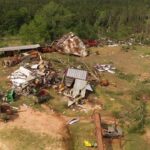
by Ron Thomas
One of the Henry County Historical Group’s most ambitious projects, the Smithsonian “Between Fences” exhibit, is set to open at the Blanche Solomon Memorial Library, 17 Park Street, Headland, on April 30th. The exhibit examines the roles that fences play in our lives and culture, inviting visitors to reflect on actual fences, borders as fences, and the invisible social fences that divide or unite our communities.
We will need persons to serve as docents, or guides, while the exhibit is here in Henry County. Mrs. Betty McGriff is in charge of recruiting and training docents. We will also need people to be greeters and help direct the public to the exhibit in the rear of the Blanche Solomon Library in Headland. I hope many of you can volunteer to help during the exhibit’s run, The HCHG extends its gratitude to Dixie Fence Company, the Alabama Power Foundation, the Alabama Humanities Foundation, and Great Southern Wood Preserving Company for their generosity in making local activities possible.
The exhibit encourages us to see that we live between fences. We may hardly notice them, but they are dominant features in our lives and in our history. The United States as we know it could not have been settled and built without fences. They continue to be an integral part of the nation. Fences stand for security. We use them to enclose our houses and neighborhoods. They are decorative structures that are as much a part of the landscape as trees and flowers. Industry and agriculture without fences would be difficult to imagine. Private ownership of land would be an abstract concept. But fences are more than functional objects. They are powerful symbols. The way we define ourselves as individuals and as a nation becomes concrete in how we build fences.
Between Fences is a Smithsonian Institution Traveling Exhibition developed for Museum on Main Street, a partnership between the Smithsonian Institution Traveling Exhibition Services (SITES) and Alabama Humanities Foundation. The tour began in 2005 and will continue through 2010, reaching at least 150 communities in 25 states. MOMS is a one-of-a kind cultural project that serves the people of rural America. Following is an overview of the exhibit: To begin with, the exhibition is divided into 5 themes: This Land Is My Land, Farm and Fence, Don’t Fence Me In, Good Fences Make Good Neighbors, and Building Borders.
Each theme has its own free-standing section, plus there is an introductory section, for a total of 6 independent components. The Between Fences exhibition for Museum on Main Street was drawn in part from a larger exhibition, Between Fences, which was on display at the National Building Museum in 1996.
Now let’s take a look at the sections of the exhibition. The first section is called “This Land is My Land” and introduces some basic concepts of the exhibition: 1. Land is the earth we live on. 2. People make land into property by owning and using it. 3. Fences define home and community. 4. Americans pursue happiness by making land their own.
Section 2 of the exhibition is called Farm and Fence and demonstrates that fences reflect and shape society, economy and environment, with farmers as our best examples. Around 1860, farm fences represented one of the largest investments of US citizens. They lasted from 10-30 years and were worth as much as $1.35 billion—at a time when the value of all farms was just $6.65 billion. To raise crops, a farmer needed to invest $2 in fences for every $1 in land. Fences separated crops and animals and framed the traditional farmstead, arranging living and working spaces into an orderly landscape.
The third primary section of the exhibition portrays fences as tools that reflect and determine who has access to resources. Was livestock fenced in or fenced out? This divisive question stood at the center of land wars fought by farmers, ranchers and lawyers. Fences reflect beliefs about who has rights to use the land and its resources. Deciding whether to fence in crops or cattle meant deciding what was public land and what was private property—and who had to pay for the fences.
The fourth section is one of the most fun and accessible parts of Between Fences. Here we see that fences are regulators of public and private property in a democratic society. Love thy neighbor? Fences are the object of disputes over privacy, noise and odor. You may think that your property line runs from the center of the planet all the way to heaven—but the person next door may disagree. Fences are two-faced structures that draw people together and keep them apart.
The fifth and last section of the Between Fences exhibition looks at how boundaries and fences in a much broader sense and how fences reflect and shape our national identity. This section juxtaposes our northern border with Canada against our southern border with Mexico. In this photo, you can see a picture of the 20 foot wide corridor, marked by obelisks, which defines the U.S./Canadian line, “the longest undefended border in the world,” separating two nations of comparable social and economic character. We hope you will visit the exhibit, will volunteer to help if you can, and will help publicize the exhibit and related activities by telling your neighbors, co-workers, and friends. It is not often that a small group like hours can present such an impressive and prestigious event, and we ask your assistance in making it a success.



